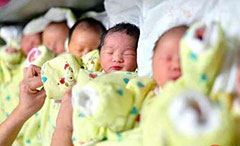Second-child policy increases births by 7.9 percent
2017-01-23
China Daily
The universal second-child policy implemented early last year was a major factor in raising the number of births in China to 17.86 million last year, an increase of 7.9 percent and the highest annual number since 2000, according to the top health authority.
The number of newborns has increased by 1.31 million compared with 2015.
The portion of the births to couples who already had at least one child rose quickly to at least 45 percent last year, Yang Wenzhuang, a division director of the National Health and Family Planning Commission, said at a news conference on Jan 22. The proportion was around 30 percent before 2013.
“It demonstrates that the universal second-child policy came in time and worked effectively,” Yang said.
“Some regions, mostly large cities in eastern areas, began recording second children as comprising more than half of local newborns,” he added.
Yang expected that by 2020, the number of new births each year would stand between 17 to 20 million in China, citing expert estimations.
Last week, Ma Xiaowei, deputy director of the commission, said a baby boom triggered largely by the new policy probably would come within the next two years.
For that, the commission plans to add 140,000 more maternity health workers in the coming years, he said.
The top decision-makers intensified efforts in late 2013 to adjust birth policies in place for three decades that limited most couples to just one child, aiming at addressing major demographic challenges such as an aging population and a looming labor shortage.
Starting in early 2014, couples in which one was an only child could have a second child. The universal second-child policy was implemented at the start of 2016.
“The long-term effect of the universal second-child policy is very helpful to China’s sustainable development,” said Yuan Xin, a professor of population studies at Nankai University in Tianjin.
By 2050, the policy is expected to bring about an extra 30 million working-age people and reduce the nation’s aging rate by 2 percent, commission projections show.
But matching policies have not yet been refined to provide good support for couples willing to have more than one child, particularly in terms of maternity education and health services, Yang conceded.
A 2015 survey by the commission found nearly 75 percent of respondents were reluctant to have a second baby, largely due to economic burdens.
Other major concerns are age, parents’ career development, and a lack of caregivers, it showed. Yuan suggested the government introduce support measures like favorable tax policies, prolonged maternity leave and education for families with two children.
As a byproduct of socioeconomic development, people tend to have smaller families, even with no birth limits, he said. “Now we might need to consider incentives for people to have more children.”
In the mid-1950s, the average number of annual births was around 18 million, almost the same as in 2016. But the fertility rate (the average number of children a woman will have during her life) has dropped from more than six then to less than two.


